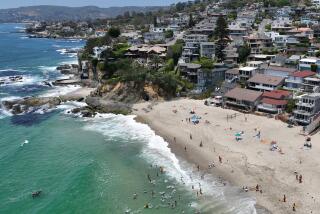A Reminder in Beach Closures
- Share via
At first an inconvenience but now a serious economic issue, the prolonged ocean pollution problems off Huntington Beach remind us of the delicate health of our Southern California shoreline. The pollution assault on miles of beach is another sign of the pressures put on natural resources by exploding regional growth.
Parts of the shoreline have been closed for weeks. Some stretches reopened this week, but large sections remain off-limits.
People who might be unfazed by an occasional day of closure have been stunned to find an eerie absence of activity along the beachfront in the heart of summer. This has produced an economic fallout for local businesses and talk of the need for disaster relief.
In recent weeks, experts have tried many ways to identify the source of the continuing pollution. This week, grapefruits and oranges were pressed into service as crews dumped them into a marsh and then tracked them as they were carried by currents into the ocean.
Recovery attempts have focused on diverting water and discharging waste farther out at sea. While these kinds of measures can bring some pollution readings to acceptable levels during beach season, they are merely Band-Aid solutions.
Some progress is being made at the grass-roots level. Armies of citizens have sprung up to rescue the great coastal regions of the Pacific. Heal the Bay in Santa Monica, for example, pressured the federal Environmental Protection Agency to set pollution limits for waterways and beaches in Los Angeles and Ventura counties. Orange County, stung by a record number of beach closings last year, led the region’s current round of efforts to increase water testing; Ventura adopted the practice early this year. Longtime resistance to implementing state requirements for standardized testing has been giving way to a more sensible philosophy: It’s better to have an informed beach-goer.
The suburban counties, for years safely outside the urban pollution belt, increasingly have suffered effects of their own growth, including runoff and strain on treatment facilities, especially during the rainy season.
Raising public awareness about the effects of pollution on the ocean environment remains a great challenge. But it’s achievable, bit by bit. Environmental ad campaigns showing that dropped trash on a sidewalk ends up in storm drain runoff--and directly or indirectly at a nearby beach--make an impression.
If Southern California’s precious beaches are to be preserved, it inevitably will take money to clean waterways and improve water treatment, as well as to sustain enforcement against polluters. But just as important, it will take an informed and committed public.
More to Read
Sign up for Essential California
The most important California stories and recommendations in your inbox every morning.
You may occasionally receive promotional content from the Los Angeles Times.













